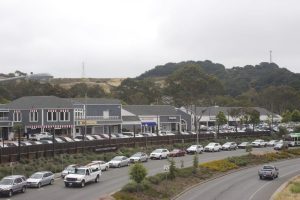The Larkspur City Council and Planning Commission is considering a proposal for a new development in Larkspur Landing, which would make for a densely populated area.
The proposal was triggered by beginning of construction on the Sonoma-Marin Area Rail Transit (SMART). To increase the density of population near the Larkspur Ferry SMART station, the Association of Bay Area Governments (ABAG) is recommending a large development around Larkspur Landing, even though the station would actually be at least a 10 minute walk from the development.
What was initially just a plan for new transportation turned into a proposal for a development.
“It’s called a Station Area Plan (SAP), but there’s no specific development proposals or any project for that matter,” said Larkspur Vice Mayor, Larry Chu.

According to Chu, the plan currently identifies potential uses for this new development, but it could still be years before it is approved.
The plan is to spread the development out over seven different sites in the Larkspur Landing area.
Julie Litzell, a Larkspur community member and a leader of Larkspur Fights Back, a small grass roots group trying to protect Larkspur from urbanization, says that the total number of planned housing units in the preferred plan is 920.
Along with the massive amount of housing units, the plan also includes over 100,000 square feet of retail and office space and a 60,00 square foot hotel. This development would be about five times the size of the development that is currently under construction in Corte Madera on Tamal Vista Boulevard, commonly referred to as the WinCup Development.
“It feels like our planning process was hijacked by an agency and their desire to urbanize Marin,” Litzell said. “Their goal is to create dense housing.”
Community activists feel that with this massive amount of housing being added to the area, there will be more people and a greater demand on our resources and infrastructure, which could be a potential problem for the Larkspur community.
“There was a very poor study done of how they will deal with the increase need for water, increase in traffic, and increase in schools,” Litzell said.
Chu agrees with Litzell in seeing no benefits from this potential development for the town.
“There are existing problems in just being able to service the community with what we have and that’s already deficient,” said Chu. “There’s not enough roadway. There are problems with not having enough water, problems with parking, and schools are already congested.”
Kathleen Mulcahy, a leader in communication between the community and the City Council of Larkspur, addressed why the community has certain concerns.
“The overall concerns that a number of us have had in the community is that the information that has be detailed in the appendixes is very historic data,” Mulcahy said. “It’s very dated and it’s nothing that’s recent. Specifically in the transportation area there’s a lot of concern because a lot of the high density that’s being proposed not only by Larkspur but also by the communities before us.”
Mulcahy discusses how many believe the community should focus on the circulation of traffic and transportation issues that already occur, rather than adding to the congestion by putting in the potential development.
The reason Mulcahy and others believe this development could potentially cause problems is because the Environmental Impact Report, which must cover all of the ways that the development would affect the area, is covering so much in this case that it might be missing some important information that it could later negatively impact the community.
“What the community is finding out is that [the Environmental Impact Report] is very weak and it’s really not at a level of detail where we can really encourage those that we’ve elected to buy off on this because we could be buying off on something that’s going to send us down into a lot of litigation later on,” said Mulcahy.
Chu says that they are currently trying to figure out when their next meeting regarding the development will be.
“I think the direction the council would like to take is to have this resolved as quickly as possible, which is to move in the direction of what they call the “no project alternative,” said Chu.
The Larkspur Planning department was contacted for their perspective on this issue but never responded.






